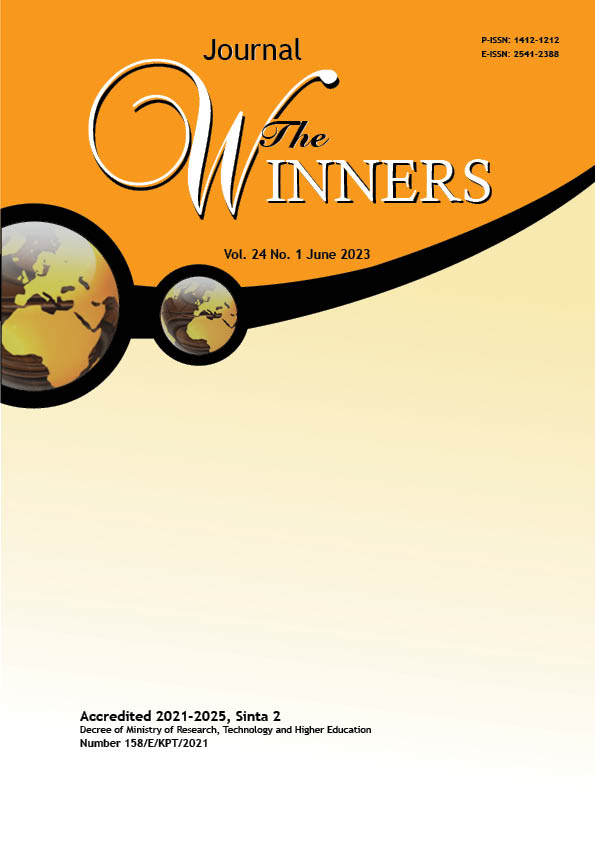Network Externality as a Mediator on Business Growth:
An Empirical Study of Multilevel Marketing Industry in Indonesia
DOI:
https://doi.org/10.21512/tw.v24i1.9700Keywords:
network externalities, business growth, multilevel marketing industryAbstract
The Multilevel Marketing (MLM) business became a more dynamic and competitive environment that drove companies to be sustainable in their business. However, the practices were sometimes perceived to be challenging by some of them. The research aimed to determine the role of network externality on Business Growth in the network marketing industry, often called MLM industry. With a non-probability sampling approach, the data were collected using structured questionnaires that were sent through emails or hardcopy. The collected data were analyzed using the PLS-SEM method with SmartPLS software. The results reveal that network externalities fully mediate both digital adoption capabilities and strategic agility to sustainable business growth. Meanwhile, network externality partially mediates the perceived product advantage to sustainable business growth. The result shall be taken into action by the companies as a key strategy in performing their business.
References
Ames, H., Glenton, C., & Lewin, S. (2019). Purposive sampling in a qualitative evidence synthesis: A worked example from a synthesis on parental perceptions of vaccination communication. BMC Medical Research Methodology, 19(1), 1-9. https://doi.org/10.1186/s12874-019-0665-4.
Arnett, D. B., Sandvik, I. L., & Sandvik, K. (2018). Two paths to organizational effectiveness – Product advantage and life-cycle flexibility. Journal of Business Research, 84, 285-292. https://doi.org/10.1016/j.jbusres.2017.11.010.
Bai, Q., Zhang, H.-L., & Song, M. (2019). Do network externalities increase customer’s recommendation to others? Empirical comparative study of luxury and necessity products? Economics, Business and Management, 194-198. https://doi.org/10.12783/dtem/icem2019/31172.
Bos-Nehles, A. C., & Veenendaal, A. A. R. (2019). Perceptions of HR practices and innovative work behavior: The moderating effect of an innovative climate. International Journal of Human Resource Management, 30(18), 2661-2683. https://doi.org/10.1080/09585192.2017.1380680.
Cen, Y., & Li, L. (2019). Effects of network externalities on user loyalty to online B2B platforms: An empirical study. Journal of Enterprise Information Management, 33(2), 309-334. https://doi.org/10.1108/JEIM-02-2019-0050.
Chan, J. I. L, & Muthuveloo, R. (2018). Key success factors for organizational performance of private HLIs in Malaysia. Strategic Direction, 34(8), 7-9. https://doi.org/10.1108/SD-03-2018-0041.
Chan, J. I. L., & Muthuveloo, R. (2019). Antecedents and influence of strategic agility on organizational performance of private higher education institutions in Malaysia. Studies in Higher Education, 46(8), 1726-1739. https://doi.org/10.1080/03075079.2019.1703131.
Clauss, T., Abebe, M., Tangpong, C., & Hock, M. (2019). Strategic agility, business model innovation, and firm performance: An empirical investigation. IEEE Transactions on Engineering Management, 68(3), 767-784. https://doi.org/10.1109/TEM.2019.2910381.
Debellis, F., De Massis, A., Petruzzelli, A. M., Frattini, F., & Del Giudice, M. (2020). Strategic agility and international joint ventures: The willingness-ability paradox of family firms. Journal of International Management, 27(1). https://doi.org/10.1016/j.intman.2020.100739.
Dommett, K. (2020). Roadblocks to interactive digital adoption? Elite perspectives of party practices in the United Kingdom. Party Politics, 26(2), 165-175. https://doi.org/10.1177/1354068818761196.
Doz, Y. (2020). Fostering strategic agility: How individual executives and human resource practices contribute. Human Resource Management Review, 30(1), 100693. https://doi.org/10.1016/j.hrmr.2019.100693.
Fürstenau, D., Cleophas, C., & Kliewer, N. (2020). How do market standards inhibit the enactment of digital capabilities? A case study of airline pricing. Business and Information Systems Engineering, 62(4), 279-287. https://doi.org/10.1007/s12599-019-00588-1.
Goto, S., Shigemoto, Y., & Ishida, S. (2019). Perceived function: An investigation into a product advantage between aesthetics and function. Journal of Technology Management and Innovation, 14(2), 33-43. https://doi.org/10.4067/s0718-27242019000200033.
Halaburda, H., Jullien, B., & Yehezkel, Y. (2020). Dynamic competition with network externalities: How history matters. RAND Journal of Economics, 51(1), 3-31. https://doi.org/10.1111/1756-2171.12304.
Hardon, A., Davatos, I. A. B., & Lasco, G. (2019). Be your product: On youth, multilevel marketing, and nutritional cure-alls in Puerto Princesa, Philippines. American Ethnologist, 46(4), 429-443. https://doi.org/10.1111/amet.12830.
Healy, B., O’Dwyer, M., & Ledwith, A. (2018). An exploration of product advantage and its antecedents in SMEs. Journal of Small Business and Enterprise Development, 25(1), 129-146. https://doi.org/10.1108/JSBED-06-2017-0206.
Hilkenmeier, F., Bohndick, C., Bohndick, T., & Hilkenmeier, J. (2020). Assessing distinctiveness in multidimensional instruments without access to raw data – A manifest Fornell-Larcker criterion. Frontiers in Psychology, 11, 1-9. https://doi.org/10.3389/fpsyg.2020.00223.
Hung, W. H., Tseng, C. L., Ho, C. F., & Wu, C. C. (2020). How social impact affects smartphone brand loyalty. Journal of Computer Information Systems, 60(5), 448-458. https://doi.org/10.1080/08874417.2018.1529514.
Kaczorowska, J., Rejman, K., Halicka, E., Szczebylo, A., & Górska-Warsewicz, H. (2019). Impact of food sustainability labels on the perceived product value and price expectations of urban consumers. Sustainability, 11(24). https://doi.org/10.3390/SU11247240.
Kale, E., Aknar, A., & Başar, Ö. (2019). Absorptive capacity and firm performance: The mediating role of strategic agility. International Journal of Hospitality Management, 78, 276-283. https://doi.org/10.1016/j.ijhm.2018.09.010.
Keong, L. S., & Dastane, O. (2019). Building a sustainable competitive advantage for Multi-Level Marketing (MLM) firms: An empirical investigation of contributing factors. Journal of Distribution Science, 17(3), 5-19. https://doi.org/10.15722/jds.17.03.201903.5.
Khan, H., & Wisner, J. D. (2019). Supply chain integration, learning, and agility: Effects on performance. Operations and Supply Chain Management, 12(1), 14-23. https://doi.org/10.31387/oscm0360218.
Khin, S., & Ho, T. C. F. (2018). Digital technology, digital capability and organizational performance: A mediating role of digital innovation. International Journal of Innovation Science, 11(2), 177-195. https://doi.org/10.1108/IJIS-08-2018-0083.
Kurniawan, R., Budiastuti, D., Hamsal, M., & Kosasih, W. (2020). The impact of balanced agile project management on firm performance: the mediating role of market orientation and strategic agility. Review of International Business and Strategy, 30(4), 457-490. https://doi.org/10.1108/RIBS-03-2020-0022.
Lee, K., & Joshi, K. (2020). Complementors’ decisions on partnership retention in markets with network externalities. International Journal of Innovation Management, 24(6). https://doi.org/10.1142/S1363919620500590.
Lee, Y. Y., Falahat, M., & Sia, B. K. (2020). Drivers of digital adoption: A multiple case analysis among low and high-tech
industries in Malaysia. Asia-Pacific Journal of Business Administration, 13(1), 80-97. https://doi.org/10.1108/APJBA-05-2019-0093.
Lungu, M. F. (2020). The influence of strategic agility on firm performance. Proceedings of the International Conference on Business Excellence, 14(1), 102-110. https://doi.org/10.2478/picbe-2020-0011.
Lyu, T., Guo, Y., & Chen, H. (2023). Understanding people’s intention to use facial recognition services: The roles of network externality and privacy cynicism. Information Technology and People. https://doi.org/10.1108/ITP-10-2021-0817.
Malshe, A., & Krush, M. T. (2020). Tensions within the sales ecosystem: A multi-level examination of the sales-marketing interface. Journal of Business and Industrial Marketing, 36(4), 571-589. https://doi.org/10.1108/JBIM-03-2020-0125.
McCartan, A. (2023). Marketing and performance in small firms: the role of networking. Journal of Research in Marketing and Entrepreneurship, 25(1), 150-182. https://doi.org/10.1108/JRME-01-2022-0007.
Mouakket, S., & Sun, Y. (2019). Examining factors that influence information disclosure on social network sites from the perspective of network externalities. Industrial Management and Data Systems, 119(4), 774-791. https://doi.org/10.1108/IMDS-02-2018-0060.
Na, Y. K., Kang, S., & Jeong, H. Y. (2019). Sub-network structure and information diffusion behaviors in a sustainable fashion sharing economy platform. Sustainability, 11(12), 1-21. https://doi.org/10.3390/su10023249.
Nicoletti, G., von Rueden, C., & Andrews, D. (2020). Digital technology diffusion: A matter of capabilities, incentives or both? European Economic Review, 128. https://doi.org/10.1016/j.euroecorev.2020.103513.
Nurjaman, R., Rahayu, A., Wibowo, L. A., & Widjajani, W. (2021). The role of strategic agility towards the firm performance of logistics service providers in Indonesia. Management Science Letters, 11, 965-974. https://doi.org/10.5267/j.msl.2020.9.046.
Nuryakin, N. (2020). Exploring SMEs marketing performance through networking capacity and relational capability. Asia Pacific Management and Business Application, 9(2), 137-150. https://doi.org/10.21776/ub.apmba.2020.009.02.5.
Pang, H., Ruan, Y., & Wang, Y. (2023). Unpacking detrimental effects of network externalities on privacy invasion, communication overload and mobile app discontinued intentions: A cognition-affect-conation perspective. Behavioral Sciences, 13(1). https://doi.org/10.3390/bs13010047.
Poon, P., & Albaum, G. (2019). Consumer trust in internet marketing and direct selling in China. Journal of Relationship Marketing, 18(3), 216-232. https://doi.org/10.1080/15332667.2019.1589244.
Pratono, A. H. (2018). From social network to firm performance: The mediating effect of trust, selling capability and pricing capability. Management Research Review, 41(6), 680-700. https://doi.org/10.1108/MRR-03-2017-0080.
Radukić, S., Mastilo, Z., & Kostić, Z. (2020). Effects of digital transformation and network externalities in the telecommunication markets. Economics, 7(2), 31-42. https://doi.org/10.2478/eoik-2019-0019.
Reed, J. H. (2020). Strategic agility and the effects of firm age and environmental turbulence. Journal of Strategy and Management, 14(2), 129-149. https://doi.org/10.1108/JSMA-07-2020-0178.
Shih, T. Y. (2018). Determinants of enterprises radical innovation and performance: Insights into strategic orientation of cultural and creative enterprises. Sustainability, 10(6). https://doi.org/10.3390/su10061871.
Somu, H., Halid, H., Nasurdin, A. M., Lim, Y. Y., & Tan, C. L. (2020). Human resource management practices (training and development, performance appraisal, and reward system) as latent predictors of job performance: A technology-based model development. Advances in Economics, Business and Management Research, 141(1), 42-47. https://doi.org/10.2991/aebmr.k.200514.010.
Tay, A., & Meng, G. (2018). Malaysia generation Y’s perceptions and attitudes towards Multilevel Marketing (MLM) career option. Journal of Humanities, Language, Culture and Business (HLCB), 2(8), 162-171.
WFDSA Annual Report. (2020). WFDSA 2019/2020.
Yao, X., Zhang, P., Lu, X., & Huang, L. (2020). Early or late? Entry timing in online IT service markets and the moderating effects of market characteristics. Journal of Business Research, 114, 265-277. https://doi.org/10.1016/j.jbusres.2020.04.023.
Yi, H. T., Yeo, C. K., Amenuvor, F. E., & Boateng, H. (2021). Examining the relationship between customer bonding, customer participation, and customer satisfaction. Journal of Retailing and Consumer Services, 62. https://doi.org/10.1016/j.jretconser.2021.102598.
Zhou, W., Su, D., Yang, J., Tao, D., & Sohn, D. (2021). When do strategic orientations matter to innovation performance of green-tech ventures? The moderating effects of network positions. Journal of Cleaner Production, 279. https://doi.org/10.1016/j.jclepro.2020.123743.
Downloads
Published
How to Cite
Issue
Section
License
Copyright (c) 2023 Asnan Furinto, Thamrin Selamet, Pantri Heriyati, Tirta Nugraha Mursitama, Mohammad Ichsan

This work is licensed under a Creative Commons Attribution-ShareAlike 4.0 International License.
Authors who publish with this journal agree to the following terms:
a. Authors retain copyright and grant the journal right of first publication with the work simultaneously licensed under a Creative Commons Attribution License - Share Alike that allows others to share the work with an acknowledgment of the work's authorship and initial publication in this journal.
b. Authors are able to enter into separate, additional contractual arrangements for the non-exclusive distribution of the journal's published version of the work (e.g., post it to an institutional repository or publish it in a book), with an acknowledgment of its initial publication in this journal.
c. Authors are permitted and encouraged to post their work online (e.g., in institutional repositories or on their website) prior to and during the submission process, as it can lead to productive exchanges, as well as earlier and greater citation of published work.
USER RIGHTS
All articles published Open Access will be immediately and permanently free for everyone to read and download. We are continuously working with our author communities to select the best choice of license options, currently being defined for this journal as follows: Creative Commons Attribution-Share Alike (CC BY-SA)

















